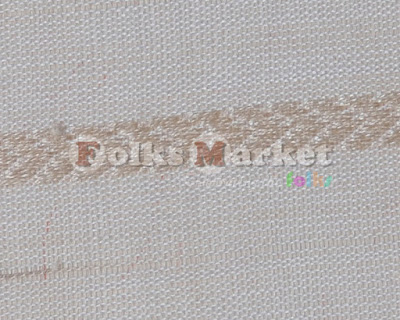Cotton is also referred to as White Gold
historically. The term is appropriate as it continues to play a dominant role
since 5000 years! Archaeologist have found cloth rags in Indus Valley
Civilization dated back to 3000 BC. In 1500 BC, the Rig-Veda (sacred Hindu
philosophy) hymn mentioned “threads in loom” which is generally accepted to be used for Cotton. Thus it is widely
believed that Cotton production started first from India. However the Egyptian
Civilization and inhabitants of Peru also knew about Cotton since ages.
Cotton is most widely used natural fibres throughout
the world. It requires sufficient moisture and heat to mature and grow quality
fibres. The fibres of Cotton are made up of cellulose. Cotton fibres are
attached to seeds inside boll of plant. A boll is made up of 6-7 seeds and near
about 20,000 fibres attached to each seed making number of fibres more than
100,000. The boll of the cotton plant is also known as Seed pod. Each fibre is
an elongated cell that has a hollow lumen inside that allows it to breath! The
adhesive quality is due to wax like outer coating.
The length of the fibre is major determinant of the
quality of the cotton. Generally long staple fibres are considered to be of
higher quality. Staple length is divided into short, medium and long.
è Short
staple is between 0.95cm and 2.4 cm in length
è Medium
staple is between 2.54 cm and 2.86 cm in length
è Long
staple could be anywhere between 3 cm to 6.35 cm
Cotton buyers buy cotton on the basis of length of
fibres (staple fibre), cleanliness, degree of whiteness and fibre strength.
Imporant Long staple cotton is Egyptian Cotton and
Pima Cotton. Pima Cotton is also called sometime as ELS (Extra Long Staple)
Cotton. Mainly grown in Peru, South West US and Australia, this is considered
to be one of the superior blends of cotton. Egyptian Cotton by far is the most
fine cotton. Towels and Sheets made from
Egyptian cotton are in great demand as
they are very soft and absorbs water quickly. Pima Cotton is similar to
Egyptian cotton. It has a little smaller staple than Egyptian cotton but still
it can be woven into dense and soft fabric.
So what makes this fibre so special? A look at its
properties will clear the air.
(Care to peek in some beautiful cotton fabric from www.folksmarket.com? Scroll till the end!)
(Care to peek in some beautiful cotton fabric from www.folksmarket.com? Scroll till the end!)
Properties
of Cotton Products
Cotton fibres are valued for its comfort, easy to
handle, affordability, natural breathing of air that soothes the skin and
ofcourse the ability of millions of weavers who use this nature’s gift
beautifully by making fabric for apparels, home furnishing, beddings, towels
and many other decorative items.
- Comfortable: Cotton has a soft texture and there is no surface irritant that brushes with the skin.
- Hydrophilic: Cotton absorbs moisture from our body. It has a strong affinity with water.
- The absorbed moisture passes through the cotton and evaporates that has a cooling effect on skin.
- Heat Conductivity: The heat conductivity of cotton is very good. This makes it dissipate heat quickly
- Fibres are strong and not prone to abrasion
- Fibres can be twisted, plied and stretched.
However couple of factors can also be enumerated unfavorably.
Notable among them are wrinkle prone fibre and dull color.
Nonetheless with the modern technique, the producers
have now overcome these difficulties. For example, cotton in its natural state
shrink by 3% but if pre treated it with certain chemicals, the effect can be
reduced. This is more so for the denim.
Moreover these days market is embracing with the fabric that is cotton blended with other fibre, like Silk and Linen.
Moreover these days market is embracing with the fabric that is cotton blended with other fibre, like Silk and Linen.
How
to wash cotton
No matter how the cotton is pre-treated, contraction
or shrinkage is inherent in nature of cotton. However, one can minimize the
shrinkage by bit extra care and following certain guidelines.
1- Always
hand-wash the cotton fabric. This is difficult for the busy people but it essentially
is the first step in fighting the shrinkage.
2- Be
it machine or hand-wash, always use the cold water rather than warm water. Hot
water agitates cotton fibre
3- After
washing, stretch your fabric, gently to neutralize its shrinkage after dry.
4- Dry
your clothes in natural sunlight. Using dryer etc make cotton fabric shrink
more.
The “White Gold” may lack color and luster but still
its most sought after natural fibre. The comfort of cotton is unmatched. This
is evident from the fact that Cotton fabric commands the major share of textile
industry globally.
To
choose wide range of cotton fabric, please visit Folksmarket.com. We have one
of the largest collections of fine cotton fabric (more than 350). Some of them
are listed below.
 |
| Cotton + Linen by Folksmarket.com |
 |
| Cotton + Silk, Zari worked by Folksmarket.com |
 |
| Cotton + Silk by Folksmarket.com |
 |
| Cotton + Silk by Folksmarekt.com |
 |
| Cotton + Silk by Folksmarket.com |
 |
| Fine Mercerized Cotton Fabric by Folksmarket.com |
 |
| Pure Cotton Fabric (merc) by Folksmarket.com |
 |
| Pure Cotton Fabric by Folksmarket.com |
The
easy to use Add to Enquiry System makes your job much easier and convenient.
You don’t need to hop in different pages to see your fabric. The entire product
can be navigated quickly and with lesser hassles.
(Folksmarket.com
also offers blended cotton fabric; cotton-silk, cotton-jute, cotton-linen are all displayed
in our website.)
What
more?? All the technical and commercial information is readily available in
your first click. Literally!!
For
more enquiry, you may drop us a mail, shakti@folksmarket.com
or subhash@folksmarket.com or Folksmarket@gmail.com
You
can call us @ +91-9899275917/+91-9630338767/+91-9818170427


No comments:
Post a Comment